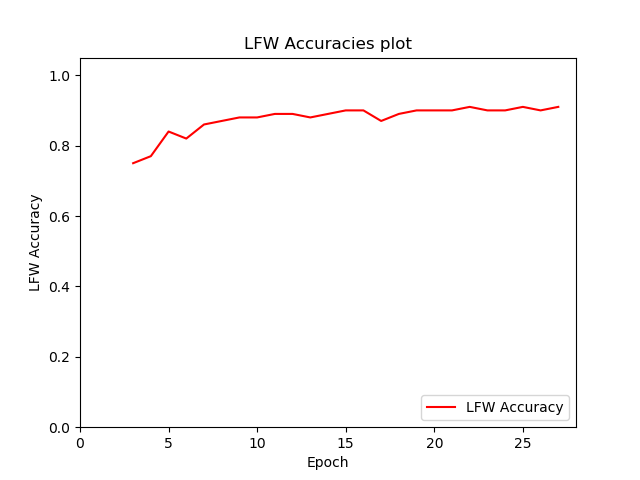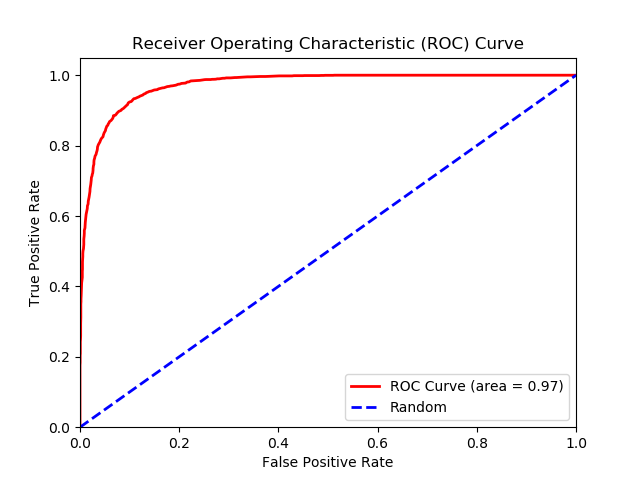Operating System: Ubuntu 18.04 (you may face issues importing the packages from the requirements.yml file if your OS differs).
A PyTorch implementation of the FaceNet [1] paper for training a facial recognition model using Triplet Loss and Cross Entropy Loss with Center Loss [2]. Training is done on the VGGFace2 [3] dataset containing 3.3 million face images based on over 9000 human identities. Evaluation is done on the Labeled Faces in the Wild [4] dataset. Please note there are overlapping identities between the two datasets since both are based on human celebrities (500 identities), overlapping identities were not removed from the training dataset in this implementation. A pre-trained model with an accuracy of 91% on the LFW dataset is provided.
Note: While the model trained on Triplet Loss achieved 91% accuracy on the LFW dataset, current implementation of the training using Center Loss with Cross Entropy Loss only manages to achieve 80-83% accuracy on the LFW dataset (only trained using the ResNet34, ResNet50, ResNet101 architectures). By looking at David Sandberg's facenet repository I suspect the Inception-Resnet architectures using Center Loss would provide a far better result but due to limited hardware (Two GTX 970 GPUs) I won't be trying this method anytime soon. If you manage to achieve a better result please let me know.
Link to download the pre-trained model using Triplet Loss here.
- Download the model weights from the link above into your project.
- Import the 'resnet34.py' module from the 'models/' folder into your project.
- Import the module and instantiate the model like the following example:
from resnet34 import Resnet34Triplet
checkpoint = torch.load('model_resnet34_triplet.pt')
model = Resnet34Triplet(embedding_dimension=checkpoint['embedding_dimension'])
model.load_state_dict(checkpoint['model_state_dict'])
best_distance_threshold = checkpoint['best_distance_threshold']
| Architecture | Loss | Embedding dimension | Margin | Training Epochs | Number of triplets per epoch | Batch Size | Optimizer | Learning Rate | LFW Accuracy | LFW Precision | LFW Recall | TAR (True Accept Rate) @ FAR (False Accept Rate) = 1e-1 | TAR (True Accept Rate) @ FAR (False Accept Rate) = 1e-2 | TAR (True Accept Rate) @ FAR (False Accept Rate) = 1e-3 |
|---|---|---|---|---|---|---|---|---|---|---|---|---|---|---|
| ResNet-34 | Triplet Loss | 128 | 0.5 | 27 | 100,000 | 64 | SGD | 0.1 | 0.9113+-0.0081 | 0.8968+-0.0127 | 0.93+-0.0151 | 0.9243+-0.0171 | 0.5683+-0.0187 | 0.2567+-0.0237 |
This model would be fine for a small-scale facial recognition system. However, for a larger-scale facial recognition system more training and a more complex model would be a better option.
- Download the VGGFace2 dataset.
- Download the Labeled Faces in the Wild dataset.
- For face alignment for both VGGFace2 and LFW datasets I used David Sandberg's face alignment script via MTCNN (Multi-task Cascaded Convolutional Neural Networks) from his 'facenet' repository: Steps to follow here and here. I used --image_size 182 --margin 44 for VGGFace2 and --image_size 160 --margin 32 for LFW, running 3 python processes on the VGGFace2 dataset took around 24 hours. I then put both train and test folders into one folder and removed the extra files resulting from the script (bounding box text files).
Note: Random triplets will be generated in this implementation and the triplet selection method is based on hard negatives (anchor_negative_distance - anchor_positive_distance < margin), the training triplets list will be saved in the 'datasets/' directory as a numpy file that can be used to start training without having to do the triplet generation step from scratch if required (see the --training_triplets_path argument in the Triplet Loss training section).
- Generate a csv file containing the image paths of the dataset by navigating to the datasets folder and running generate_csv_files.py:
usage: generate_csv_files.py [-h] --dataroot DATAROOT [--csv_name CSV_NAME]
Generating csv file for triplet loss!
optional arguments:
-h, --help show this help message and exit
--dataroot DATAROOT, -d DATAROOT
(REQUIRED) Absolute path to the dataset folder to
generate a csv file containing the paths of the images
for triplet loss.
--csv_name CSV_NAME Required name of the csv file to be generated.
(default: 'vggface2.csv')
-
Type in
python train_triplet.py -hto see the list of training options. Note: '--dataroot' and '--lfw' arguments are required. -
To train run
python train_triplet.py --dataroot "absolute path to dataset folder" --lfw "absolute path to LFW dataset folder" -
To resume training run
python train_triplet.py --resume "path to model checkpoint: (model.pt file)" --dataroot "absolute path to dataset folder" --lfw "absolute path to LFW dataset folder" -
(Optional) To resume training but with skipping the triplet generation process if it was done already; run:
python train_triplet.py --training_triplets_path "datasets/training_triplets_100000.npy" --resume "path to model checkpoint: (model.pt file)" --dataroot "absolute path to dataset folder" --lfw "absolute path to LFW dataset folder"
usage: train_triplet.py [-h] --dataroot DATAROOT --lfw LFW
[--dataset_csv DATASET_CSV]
[--lfw_batch_size LFW_BATCH_SIZE]
[--lfw_validation_epoch_interval LFW_VALIDATION_EPOCH_INTERVAL]
[--model {resnet18,resnet34,resnet50,resnet101,inceptionresnetv2}]
[--epochs EPOCHS]
[--training_triplets_path TRAINING_TRIPLETS_PATH]
[--num_triplets_train NUM_TRIPLETS_TRAIN]
[--resume_path RESUME_PATH] [--batch_size BATCH_SIZE]
[--num_workers NUM_WORKERS]
[--embedding_dim EMBEDDING_DIM]
[--pretrained PRETRAINED]
[--optimizer {sgd,adagrad,rmsprop,adam}] [--lr LR]
[--margin MARGIN]
Training FaceNet facial recognition model using Triplet Loss.
optional arguments:
-h, --help show this help message and exit
--dataroot DATAROOT, -d DATAROOT
(REQUIRED) Absolute path to the dataset folder
--lfw LFW (REQUIRED) Absolute path to the labeled faces in the
wild dataset folder
--dataset_csv DATASET_CSV
Path to the csv file containing the image paths of the
training dataset.
--lfw_batch_size LFW_BATCH_SIZE
Batch size for LFW dataset (default: 64)
--lfw_validation_epoch_interval LFW_VALIDATION_EPOCH_INTERVAL
Perform LFW validation every n epoch interval
(default: every 1 epoch)
--model {resnet18,resnet34,resnet50,resnet101,inceptionresnetv2}
The required model architecture for training:
('resnet18','resnet34', 'resnet50', 'resnet101',
'inceptionresnetv2'), (default: 'resnet34')
--epochs EPOCHS Required training epochs (default: 30)
--training_triplets_path TRAINING_TRIPLETS_PATH
Path to training triplets numpy file in 'datasets/'
folder to skip training triplet generation step.
--num_triplets_train NUM_TRIPLETS_TRAIN
Number of triplets for training (default: 100000)
--resume_path RESUME_PATH
path to latest model checkpoint:
(Model_training_checkpoints/model_resnet34_epoch_0.pt
file) (default: None)
--batch_size BATCH_SIZE
Batch size (default: 64)
--num_workers NUM_WORKERS
Number of workers for data loaders (default: 4)
--embedding_dim EMBEDDING_DIM
Dimension of the embedding vector (default: 128)
--pretrained PRETRAINED
Download a model pretrained on the ImageNet dataset
(Default: False)
--optimizer {sgd,adagrad,rmsprop,adam}
Required optimizer for training the model:
('sgd','adagrad','rmsprop','adam'), (default: 'sgd')
--lr LR Learning rate for the optimizer (default: 0.1)
--margin MARGIN margin for triplet loss (default: 0.5)
The best performing model was a ResNet-50 model trained using the default settings in train_center.py for 250 epochs, yet the best LFW accuracy was 83%, an Inception-Resnet architecture may provide a far better result. If you manage to achieve a better result please let me know.
-
Type in
python train_center.py -hto see the list of options of training.Note: '--dataroot' and '--lfw' arguments are required!
-
To train run
python train_center.py --dataroot "absolute path to dataset folder" --lfw "absolute path to LFW dataset folder" -
To resume training run
python train_center.py --resume "path to model checkpoint: (model.pt file)" --dataroot "absolute path to dataset folder" --lfw "absolute path to LFW dataset folder"
usage: train_center.py [-h] --dataroot DATAROOT --lfw LFW
[--lfw_batch_size LFW_BATCH_SIZE]
[--lfw_validation_epoch_interval LFW_VALIDATION_EPOCH_INTERVAL]
[--model {resnet18,resnet34,resnet50,resnet101,inceptionresnetv2}]
[--epochs EPOCHS] [--resume_path RESUME_PATH]
[--batch_size BATCH_SIZE] [--num_workers NUM_WORKERS]
[--valid_split VALID_SPLIT]
[--embedding_dim EMBEDDING_DIM]
[--pretrained PRETRAINED]
[--optimizer {sgd,adagrad,rmsprop,adam}] [--lr LR]
[--center_loss_lr CENTER_LOSS_LR]
[--center_loss_weight CENTER_LOSS_WEIGHT]
Training FaceNet facial recognition model using Cross Entropy Loss with Center
Loss.
optional arguments:
-h, --help show this help message and exit
--dataroot DATAROOT, -d DATAROOT
(REQUIRED) Absolute path to the dataset folder
--lfw LFW (REQUIRED) Absolute path to the labeled faces in the
wild dataset folder
--lfw_batch_size LFW_BATCH_SIZE
Batch size for LFW dataset (default: 64)
--lfw_validation_epoch_interval LFW_VALIDATION_EPOCH_INTERVAL
Perform LFW validation every n epoch interval
(default: every 5 epochs)
--model {resnet18,resnet34,resnet50,resnet101,inceptionresnetv2}
The required model architecture for training:
('resnet18','resnet34', 'resnet50', 'resnet101',
'inceptionresnetv2'), (default: 'resnet34')
--epochs EPOCHS Required training epochs (default: 275)
--resume_path RESUME_PATH
path to latest model checkpoint:
(Model_training_checkpoints/model_resnet34_epoch_0.pt
file) (default: None)
--batch_size BATCH_SIZE
Batch size (default: 128)
--num_workers NUM_WORKERS
Number of workers for data loaders (default: 4)
--valid_split VALID_SPLIT
Validation dataset percentage to be used from the
dataset (default: 0.01)
--embedding_dim EMBEDDING_DIM
Dimension of the embedding vector (default: 128)
--pretrained PRETRAINED
Download a model pretrained on the ImageNet dataset
(Default: False)
--optimizer {sgd,adagrad,rmsprop,adam}
Required optimizer for training the model:
('sgd','adagrad','rmsprop','adam'), (default: 'sgd')
--lr LR Learning rate for the optimizer (default: 0.1)
--center_loss_lr CENTER_LOSS_LR
Learning rate for center loss (default: 0.5)
--center_loss_weight CENTER_LOSS_WEIGHT
Center loss weight (default: 0.007)
state = {
'epoch': epoch+1,
'embedding_dimension': embedding_dimension,
'batch_size_training': batch_size,
'model_state_dict': model.state_dict(),
'model_architecture': model_architecture,
'optimizer_model_state_dict': optimizer_model.state_dict(),
'best_distance_threshold': best_distance_threshold
}
state = {
'epoch': epoch+1,
'num_classes': num_classes,
'embedding_dimension': embedding_dimension,
'batch_size_training': batch_size,
'model_state_dict': model.state_dict(),
'model_architecture': model_architecture,
'optimizer_model_state_dict': optimizer_model.state_dict(),
'optimizer_centerloss_state_dict': optimizer_centerloss.state_dict(),
'learning_rate_scheduler_state_dict': learning_rate_scheduler.state_dict(),
'best_distance_threshold': best_distance_threshold
}
- https://github.com/davidsandberg/facenet
- https://github.com/liorshk/facenet_pytorch
- https://github.com/KaiyangZhou/pytorch-center-loss (imported 'center_loss.py' from this repository).
- https://github.com/tbmoon/facenet ('triplet_loss.py' and 'triplet_loss_dataloader.py' were imported from this repository)
-
[1] Florian Schroff, Dmitry Kalenichenko, James Philbin, “FaceNet: A Unified Embedding for Face Recognition and Clustering”: paper
-
[2] Yandong Wen, Kaipeng Zhang, Zhifeng Li, Yu Qiao, "A Discriminative Feature Learning Approachfor Deep Face Recognition": paper
-
[3] Q. Cao, L. Shen, W. Xie, O. M. Parkhi, A. Zisserman "VGGFace2: A dataset for recognising faces across pose and age": paper, dataset
-
[4] Gary B. Huang, Manu Ramesh, Tamara Berg, and Erik Learned-Miller. "Labeled Faces in the Wild: A Database for Studying Face Recognition in Unconstrained Environments": paper

